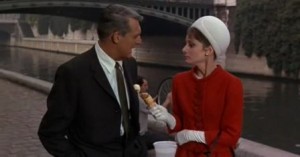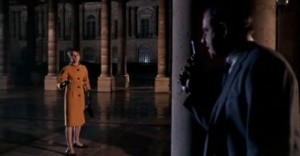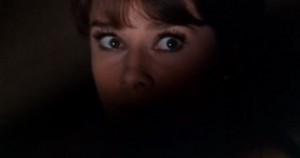 As Cary and Audrey are walking the Quai de la Toumelle along the Seine, he buys her an ice cream cone from a vendor. As they continue, talking small talk, she, seemingly in a natural hand gesture with the cone, topples the ice cream on his suit. This, if memory serves me right, was unscripted; there is a certain instinctive surprise on Grant’s face, but the two stars continue the scene. Until the director cries “cut,” even the beginning performer knows to continue.
As Cary and Audrey are walking the Quai de la Toumelle along the Seine, he buys her an ice cream cone from a vendor. As they continue, talking small talk, she, seemingly in a natural hand gesture with the cone, topples the ice cream on his suit. This, if memory serves me right, was unscripted; there is a certain instinctive surprise on Grant’s face, but the two stars continue the scene. Until the director cries “cut,” even the beginning performer knows to continue.
At the end of the scene, Hepburn wonders if Quasimodo really did swing on his rope from the nearby towers. Grant looks up. The camera tilts up. There, across the Seine of course, is Notre-Dame Cathedral. “Who put that there?” Grant asks.
Besides the express and the Métro trains and several overhead shots, Hitchcockian touches abound, undoubtedly intentional. Early on, a German luger—in this case a boy’s water pistol—appears starkly from behind an umbrella, full screen; in The Man Who Knew Too Much (1956 version), a real luger emerges from behind a curtain. There’s a foot chase through the congested aisles of the Carré Marigny stamp fair, much as John Williams chased Grant through a flower garden in To Catch a Thief.
North by Northwest is plagiarized at least thrice. When Grant pursues Kennedy across a fire escape and passes a hotel window, he hears a wife within say to her husband, “It happened again!,” a man staring in at her. In the Hitch film, Grant steps into a bedroom through a window, crosses the room and says to the glee-eyed woman sitting up in the bed, “A-a-a-a—.”
In a scene at the American Express, Hepburn and Grant converse from two different booths in a row of telephones; for Hitch it is Eva Marie Saint and Martin Landau at Grand Central Station. In Charade, Grant takes a shower wearing his suite, a perfect vaudevillian sketch; in North by Northwest, he only runs the shower for Saint’s benefit. This last, however, may be a stretch of coincidence.
And, of course, in many of Hitch’s works, a highly dramatic moment or the final confrontation between the protagonists occurs in public, most often in a theater—The 39 Steps, Torn Curtain, Downhill, Sabotage, Stage Fright, Murder, both versions of The Man Who Knew Too Much, Young and Innocent, Saboteur, etc.—and, if handy, in a famous place—Mount Rushmore (North by Northwest), the British Museum (Blackmail), the Statue of Liberty (Saboteur), Royal Albert Hall (The Man Who Knew Too Much versions) and the Château Frontenac Hotel in Quebec (I Confess).
 Charade has a double famous-location climax—first a shootout among the columns of the famous Palais-Royal, then the villain flees to, yes, a theater, the Théâtre du Palais-Royal. As in Stage Fright, there is much scurrying under the stage, much tension. In Stage Fright, Richard Todd is crushed beneath a safety curtain; in Charade, the bad guy is dropped to his death when Grant opens beneath him one of the stage’s trap doors, a rather unrealistic fall, then a stiff pitch away, legs unbroken.
Charade has a double famous-location climax—first a shootout among the columns of the famous Palais-Royal, then the villain flees to, yes, a theater, the Théâtre du Palais-Royal. As in Stage Fright, there is much scurrying under the stage, much tension. In Stage Fright, Richard Todd is crushed beneath a safety curtain; in Charade, the bad guy is dropped to his death when Grant opens beneath him one of the stage’s trap doors, a rather unrealistic fall, then a stiff pitch away, legs unbroken.
Some critics attribute Hitchcock’s fondness for processed shots to laziness. Maybe. In Charade, some of the rear screen projection is, now, most unconvincing, especially of the Paris scenery as Grant and Hepburn glide down the Seine on a dinner river cruise, though in 1963 it must have been somewhat impressive.
Please, on this last note, don’t be dissuaded from seeing Cary Grant and Audrey Hepburn at their finest, or giving Charade a second go. Henry Mancini composed one of his finest scores, varying from lighthearted piano to an ominous, vibrating drone at times. Johnny Mercer’s lyrics to “Charade” won a Best Song Oscar nomination. James Clark’s editing is tight, Charles Lang’s cinematography vivid and varied. Director Donen’s nimble pace proves, perhaps, that he knew his . . . er . . . Hitchcock? If some viewers should feel the plot slows down occasionally—the overly long Seine cruise comes to mind—there’s that crackling dialogue to hold the interest, and the charisma of the two stars.
The Cary Grant persona, certainly this late in his career, would never permit him to be the villain, and no one who watches Charade would ever think he is the one—yes, there’s only one! There are, however, some titillating subtleties that might suggest otherwise: his silhouette when he arrives at Regina’s apartment, his presumed connivance at one point with the criminals, the three aliases before he arrives at his real name and the occasional sinister cues in Mancini’s music.
 Grant, who managed—and guarded—his career as much and as well as any star, knew when to leave the screen, and he did so when he was on top, obviously. Much longer and the image of the old suitor pursuing women young enough to be his daughters would, indeed, have become ridiculous. He would live twenty more years after his last film, Walk Don’t Run. The one actor who most reminds me of Grant, both in his debonair persona and in physical grace, and who also exited with exquisite timing, was William Powell. Powell would live thirty years after his last film, Mr. Roberts.
Grant, who managed—and guarded—his career as much and as well as any star, knew when to leave the screen, and he did so when he was on top, obviously. Much longer and the image of the old suitor pursuing women young enough to be his daughters would, indeed, have become ridiculous. He would live twenty more years after his last film, Walk Don’t Run. The one actor who most reminds me of Grant, both in his debonair persona and in physical grace, and who also exited with exquisite timing, was William Powell. Powell would live thirty years after his last film, Mr. Roberts.
In Charade, Cary has strong competition in Audrey—she is lovely and acts endearingly, reminiscent of her roles in Roman Holiday and Sabrina—but the old man manages, I think at least, to steal the show, if, admittedly, only by the slightest margin. His nonchalant charm—all comes so naturally to him—and even the grace of his movements, acquired from those early vaudeville days, help to belie his age. Yep, at sixty, I think the old man has gotten away, once again, with murder.
Charade has been through a glitch in the copyright law, in the public domain since its original release. There are countless versions available on DVD, but a completely restored high quality edition has been released by the Criterion Collection.
Thanks for the article on this great film. When I saw this film many years ago, I thought there was a lot more to the suffocation scene. Did it get deleted, or am I thinking of a different movie?
Thanks again.